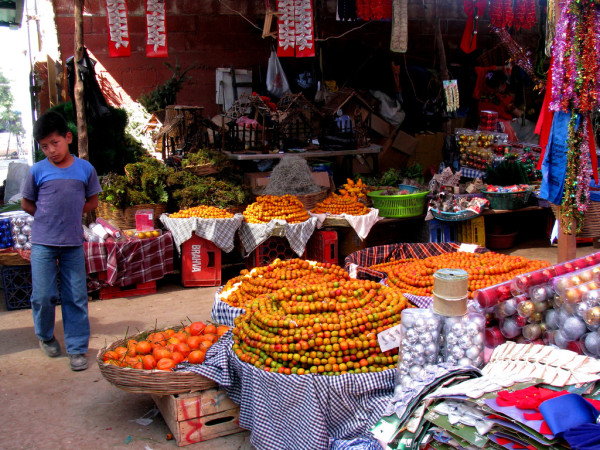Sights and Sounds of Christmastime in Guatemala
Christmas colors in Guatemala don’t stop with red and green, and dreams of a white Christmas must also include the entire rainbow. Yes, the brilliant red poinsettias and fragrant green pine needles, the ripe red berries and deep green leaves of the coffee trees, give all Central America the traditional Christmas colors of much of the world, but holidays in Guatemala don’t stop there.
Despite the usual spring-like weather, under a deep bowl of sky-blue, every other color comes to brighten December in Guatemala. Fire-red begins the month, with bright bonfires flaming against deep dark skies on the night of December 7 with the Quema del Diablo, the Burning of the Devil. Meanwhile, plants and trees that don’t bloom in the winter of the northern hemisphere burst into Christmas colors for Central America: purple jacarandas, scarlet pie-de-gallos, bright little yellow gourds, golden manzanillas in bead-like strings and, of course, roses and carnations in every shade, creamy lilies and brilliant bougain-villea climbing the sunlit white walls to mix with the red tile roofs.
To see the full range of December shades, look at the woven head-baskets atop Mayan ladies in the markets and along the streets, filled with color to festoon their homes and to weave between windows on the buses, signifying the holidays. There may be a golden pineapple and orange-green citrus, some yellow or green squash and red tomatoes and generally bunches of fresh flowers for the table and home.
December is more a month of family celebrations than a commercial time, though red-suited Santas and green plastic trees sprinkle the streets by courtesy of some businesses. It’s in homes, at the back of little stores, at the entrances of hospitals and churches, that one finds the special blend of colors for a Guatemalan Christmas.
Nacimientos, nativity scenes that sometimes take up half the space of a family’s home, mix grey and silver mosses, green pine, golden little mountains and buildings, even sometimes flowing water, miniature people and animals and a tiny crib covered with a rich white cloth. Only at midnight on Christmas Eve does the youngest child of the family lift off the white cloth to the prayers of the others watching, unveiling the golden little child in the cradle.
Sounds are so important on Christmas Eve, too, loud sounds, part of the holiday. Marimbas lead dances all evening, with church bells incessantly ringing as midnight approaches. Then giant bombs, strings of firecrackers and shattering mortar blasts take over to temporarily deafen those too close and to echo in every part of town. But Christmas colors continue that night in the homes, brown tones of hot chocolate or coffee in the family’s best cups, grapes and apples in many shades and especially tamales colorados.
Christmas without red tamales would be like-well, it just wouldn’t be. Every family kitchen has been busy making the special holiday treat, ready for this evening, the deep green wrapper holding soft brown meal stuffed with maroon and purple meats. A tamal for everyone is important, to share with friends and the whole neighborhood.
Christmas Day and evening quiets down, but the year-end holidays don’t stop, flowing on into January, even to the start of Lent. Why should colorful nacimientos be limited to December or the celebrations end with the Rose Parade or Super Bowl as in the North? Many of the nativity scenes are too delightful to go quickly and too symbolic to lose in a home. Green pine and red poinsettias continue for weeks as bright decorations. The rainbow colors of Guatemala are for every day of the year, with a special mix of traditional colors saved for these weeks of joyful holiday
photo: Ventas navideñas de los campos del Roosevelt by Roberto Urrea (cc license)
